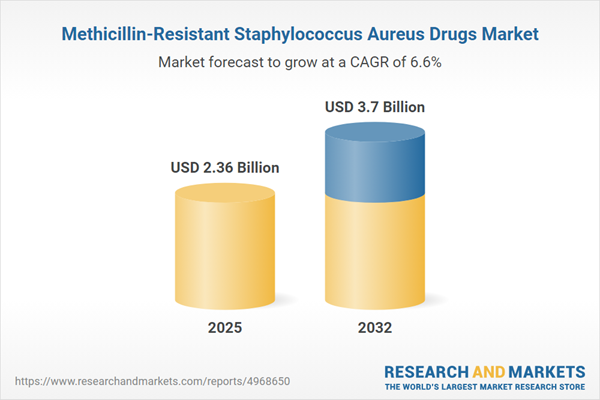Speak directly to the analyst to clarify any post sales queries you may have.
The MRSA drugs market is undergoing significant transformation as healthcare organizations worldwide adapt to evolving antimicrobial resistance patterns and new models of care. Senior leaders must navigate heightened operational, regulatory, and technology challenges to maintain growth and compliance.
Market Snapshot: MRSA Drugs Market Outlook
The global Methicillin-Resistant Staphylococcus Aureus (MRSA) drugs market is projected to grow from USD 2.21 billion in 2024 to USD 2.36 billion in 2025, representing a compound annual growth rate of 6.62%. This momentum is fueled by increased clinical demand for effective MRSA therapies and ongoing problems related to resistance against existing options. To address these dynamics, health systems are updating protocols, advancing the adoption of innovative treatments, and focusing on rapid integration of novel MRSA drugs. There is also a visible shift in strategic direction, with both large pharmaceutical firms and emerging biotech players intensifying their collaboration with clinical partners for improved patient outcomes. As operational standards strengthen, organizations are swiftly integrating therapeutic innovations, transforming care models across diverse geographies and clinical settings.
Scope & Segmentation: Executive Analysis of the MRSA Drugs Market
This executive report equips leaders to capitalize on emerging MRSA drug market opportunities, manage risk, and optimize resources. Strategic segmentation enables focused decision-making and robust execution, particularly in areas of pronounced growth and innovation:
- Administration Route: Addresses both intravenous and oral MRSA therapies, focusing on improving patient adherence, shortening inpatient stays, and expanding access to outpatient options.
- Patient Type: Compares inpatient and outpatient treatment modalities, emphasizing their distinct clinical challenges and resource requirements for care delivery.
- Drug Class: Investigates the roles and advances in cephalosporins, glycopeptides, lipopeptides, oxazolidinones, and tetracyclines, highlighting practice changes and innovation trends relevant to clinical leaders.
- Distribution Channel: Analyzes hospital, retail, and digital pharmacy ecosystems, revealing strategic benefits for logistics and adaptability between centralized and decentralized points of care.
- Regional Coverage: Includes North America, Europe, Asia-Pacific, Middle East and Africa, and Latin America, providing actionable insights to refine strategies to local regulatory and market contexts.
- Company Coverage: Reviews the activities of industry leaders such as Innovation Pharmaceuticals Inc., Johnson & Johnson Services, Inc., and AbbVie Inc., focusing on their approaches to partnerships and differentiation within a competitive landscape.
This segmentation framework empowers executive teams to respond proactively to regulatory shifts, harness evolving treatment technologies, and customize business strategies to regional and clinical variations.
Key Takeaways for Market Leadership
- Ongoing development of MRSA drugs is supporting more precise, patient-targeted care, ensuring clinical approaches align with the specific requirements of various healthcare settings and risk profiles.
- Advanced diagnostics are now leveraging both genetic and clinical data, assisting healthcare leaders in personalizing MRSA management protocols and therapy selection.
- The transformation towards oral MRSA therapies is facilitating a greater shift to outpatient care, decreasing reliance on inpatient resources and optimizing treatment efficiency.
- Strengthened collaboration across manufacturing, distribution, and healthcare networks has improved supply chain insights and supported adherence to evolving regulatory frameworks.
- Utilization of analytics and adaptive procurement practices is enhancing supply continuity and readiness for disruptions linked to either regulatory or external market changes.
- Timely alignment with payer and regulatory requirements is reducing compliance gaps, positioning organizations for improved operational resilience and performance.
Tariff Impact on MRSA Drugs Supply Chains
Recent changes in U.S. tariff policies have prompted MRSA drug manufacturers to explore nearshoring and broaden supplier networks. Stakeholders are increasingly using real-time analytics and flexible logistics to mitigate supply interruptions and maintain operational resilience in an uncertain trade landscape.
Methodology & Data Sources
This market assessment draws upon direct input from clinicians, pharmacists, supply chain specialists, and regulatory authorities. All data points are validated with recent clinical research and trusted industry references to support confident executive decision-making.
Why This MRSA Drugs Market Report Matters
- Enables senior executives to develop strategies that anticipate regulatory and market shifts across the MRSA drugs landscape.
- Pinpoints areas of compliance exposure and guides operational enhancements that bolster supply network stability and resource alignment.
- Supports competitive positioning by aligning organizational processes with current technology advancements and regulatory expectations.
Conclusion
This report delivers vital insights and structured guidance, equipping senior decision-makers to skillfully navigate the evolving MRSA drugs market and strengthen their organizations’ strategic direction.
Additional Product Information:
- Purchase of this report includes 1 year online access with quarterly updates.
- This report can be updated on request. Please contact our Customer Experience team using the Ask a Question widget on our website.
Table of Contents
3. Executive Summary
4. Market Overview
7. Cumulative Impact of Artificial Intelligence 2025
Companies Mentioned
The companies profiled in this Methicillin-Resistant Staphylococcus Aureus Drugs market report include:- Innovation Pharmaceuticals Inc.
- Johnson & Johnson Services, Inc.
- AbbVie Inc.
- Armata Pharmaceuticals, Inc.
- AstraZeneca PLC
- Basilea Pharmaceutica Ltd.
- Bausch Health Companies Inc.
- Cardinal Health, Inc.
- Cumberland Pharmaceuticals Inc.
- Merck & Co., Inc.
- Novartis AG
- Paratek Pharmaceuticals, Inc.
- Pfizer Inc.
- Takeda Pharmaceutical Company Limited
- Teva Pharmaceutical Industries ltd
Table Information
| Report Attribute | Details |
|---|---|
| No. of Pages | 181 |
| Published | October 2025 |
| Forecast Period | 2025 - 2032 |
| Estimated Market Value ( USD | $ 2.36 Billion |
| Forecasted Market Value ( USD | $ 3.7 Billion |
| Compound Annual Growth Rate | 6.6% |
| Regions Covered | Global |
| No. of Companies Mentioned | 15 |









